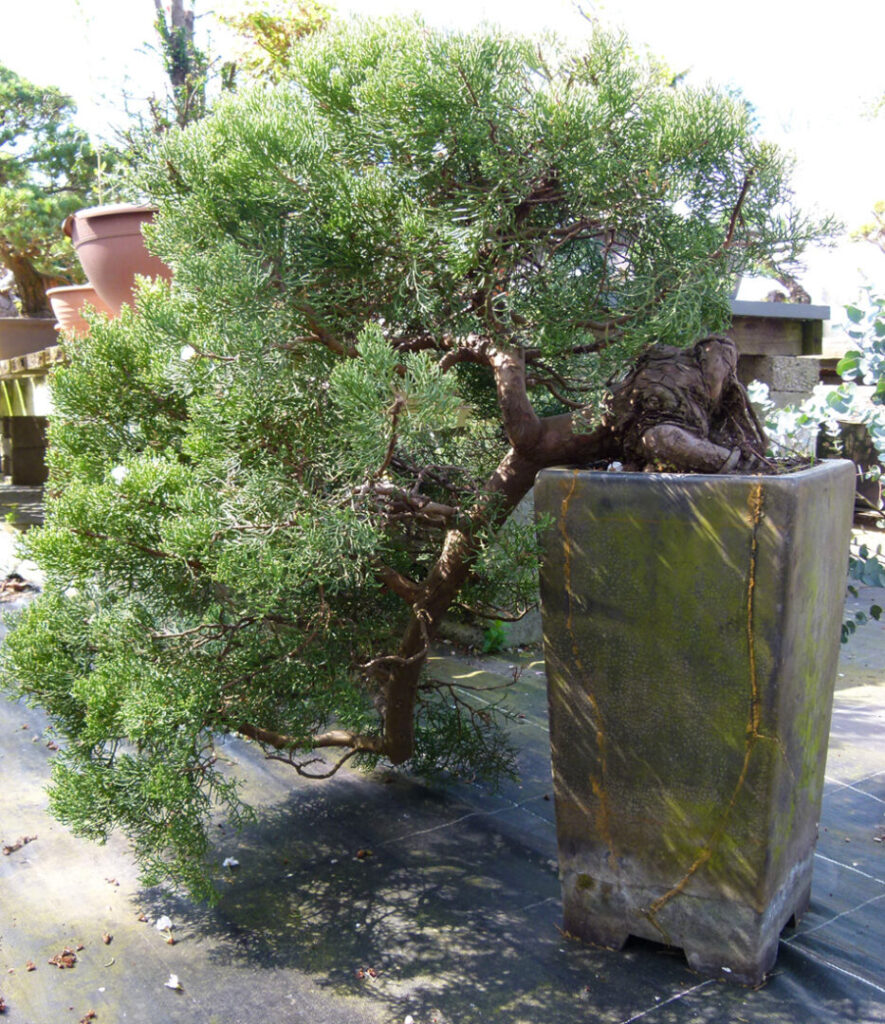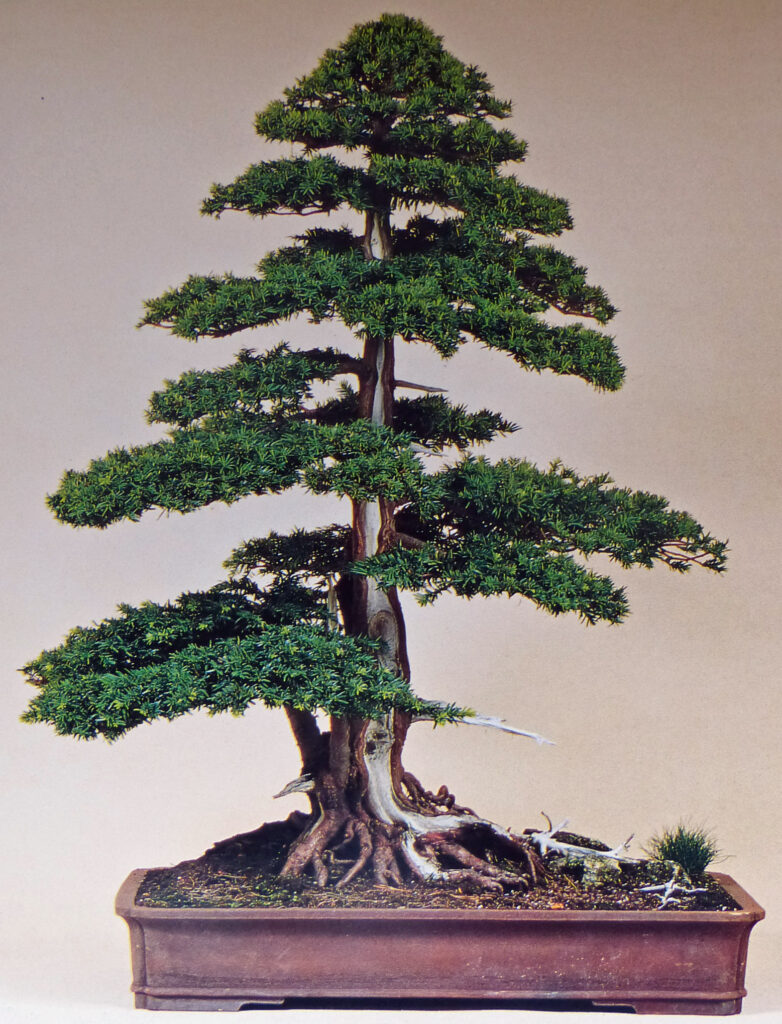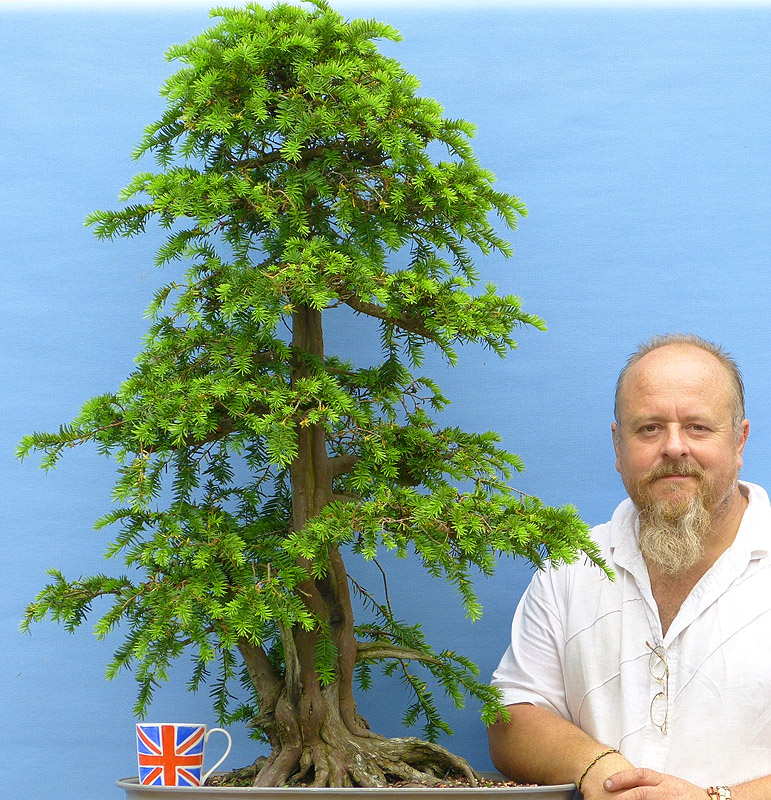Great British Bonsai
Over the last few years I have been buying up a lot of bonsai collections. As a result I have obtained some previously unknown or unseen Great British Bonsai. Typically when that happens I buy everything, we buy live trees, a few dead ones, the benches, old pots, tools, books lock stock the f***** lot. This makes folk very happy to know that what is often decades of their hard work is assured a good future. I don’t sell these trees to just anyone, in fact I mostly don’t sell them at all. It’s sad when we have to part with our trees but that’s life, in the end we leave it all behind.
Sometimes folk have left it a bit too long and some of the trees can be in less than perfect condition, sadly on occasions they are hanging by a thread. These days I spend a great deal of my time restoring and rehabilitating these old soldiers. I have always said that in order to produce significant bonsai long term one must be a gardener first and foremost. You’ll never show if you can’t grow. It’s impossible to create a bonsai tree from a plant that is not growing vigorously no matter how skilful one might be with the wire. Thankfully over the last 40 odd years I have honed my gardening skills somewhat. Within the constraints of the British climate I can grow most anything these days.
The great thing about collections is the discovery of interesting and unusual varieties and bonsai that sometimes have an interesting or long history. I have some very odd plants in my garden and even though they may not be classical beauties I love them. Often the original owners don’t know what they are. 2022 I bought what I was told (and thought) was a massive cascade juniper with strange coarse foliage. This had been in the hands of a gentleman since the 1970s. Nobody who visited could place it but just last week, after it had been here a couple of years I suddenly realised it was cupressus, as in a variety of Italian cypress. Sometimes I’m really slow.

Turns out this was not a juniper at all but cupressus from the 1970s. DOHH!
Not all collections are tired, some are simply amazing. I recently acquired a pair of absolutely stunning Japanese larch, collected in the highlands over 40 years ago along with some old collected Scottys. Most of you hopefully saw the old twin trunk larch growing out of a rock I potted recently and there are a whole host of other amazing old bits here that hopefully I can introduce ya’ll to as time goes on.
Unlike some parts of the world, bonsai is a fairly recent introduction to our country. Bonsai may pop up around the periphery of British history prior to the 1970s but these were little more than glimpses of oriental culture and curiosity. Back when I started bonsai there were a few books and Colin Lewis had not long since begun publishing Bonsai Magazine here. A far cry from today indeed. There were few professional bonsai artists working in GB back then and a bonsai show was typically a niche event hosted by a fledgling bonsai club within the confines of a larger horticultural event….with very limited exceptions.
Let me interject with something i’m pretty sure I have recounted here before about Mr Doubleday. He was the first person that I met in the bonsai world and inspired me to take up my life’s work. A third generation nurseryman who produced roses from his little nursery on Walnut Hill, deepest Norfolk. He lived in a caravan without electricity, wore tweed, a brown felt hat and hobnail boots and had hands like ancient gnarled branches. His father had seen bonsai in the far east during the war and decades lated Mr D was still practicing the art. Andrew had trees he and his father cultivated together from the end of the 1940’s. I still have a couple of those trees but I can be sure nobody but a couple of local old hacks and I might know him. Mr D would be well up in his nineties by now assuming he’s still about but a little of his work lives on here.
In my experience bonsai clubs typically frowned upon “check book bonsai”. My own local club banned showing any tree one had simply purchased. Hoping to encourage home grown talent though with limited learning opportunities i’m not sure how that was supposed to work. That’s all a little bit off IMHO.
As I have said many times, when buying a bonsai tree or raw material all one is doing is shortening the timeframe involved. Now if you buy something nice it’s not right to go and claim credit for the work that went into producing it but one can be happy with the pride of ownership. If after several years one has significantly improved your charge then a degree of credit can legitimately be claimed. I often wondered what my club hoped to do with those rules. In the end it largely discouraged good bonsai and ensured mediocrity and might go some way to explain how membership fell from 70/80 in the early 2000s to a typical attendance these days in single figures but I digress.
With very few notable exceptions there were few ‘names‘ producing great bonsai back in the day. In time some trees did get here from Japan but mostly finding something special was akin to a blind squirrel looking for nuts, one had to get lucky. And so, we have very few trees from the dark ages* that one might perhaps call heritage bonsai or some such. In the past I have owned some famous bonsai like the yew that launched Kevin Willson’s bonsai career commonly known as ‘The Upright’, I also owned ‘The Bow’ and stupidly sold both. Now I am older I think differently but then I am not broke like I was back then which makes all the difference. I sold both these for practically no money because I failed to realise perhaps just what I had even though both were a little tired at the time.

Kevin Willsons ‘Upright’ at the peak of its development.

I sold this famous old tree so cheap it brings a tear to my eye now. If you have it, I’ll buy it back!
So, whilst big names with big impressive trees were somewhat scarce in blighty back in the day there was an absolute army of enthusiasts and hobbyists alike scouring every corner to find good bonsai material. Thankfully some of those guys persevered over many decades and as it turned out, produced some pretty good, dare I say Great British Bonsai. Lucky SOB that I am a few are residing upon my benches as I sit here. Some need help but others are special and unique and need a little respect for being simply amazing even if they don’t conform to what some folk think a bonsai should be or look like.
It’s no secret I am a total car crash when it comes to dealing with people. My social skills are by and large non existent. Just a couple of days ago I took Catherine grocery shopping (first time in years) and got a right bollocking simply for getting something out of a chiller cabinet in the wrong (and inconsiderate) way. It’s a long story I would rather not go into. I am utterly hopeless, clueless and entirely feckless with absolutely NO understanding of how these things work. By and large I prefer my own company and work hard at avoiding social contact because I am so bad at it my head hurts. I don’t hate people I just don’t get how it all works and so usually end up with my foot in my mouth. I have tried very hard but Catherine says I ‘just don’t get it’. Apparently i’m too ‘task orientated‘ whatever that is.
So with other folk not exactly big on my radar I find it a little strange to be thinking about the people who’s work I now have entrusted to me. I have been thinking a lot about what little bonsai legacy we have in GB and how to both raise awareness and respect for the old bonsai we do have. Do we have a moral, social or ethical responsibility to keep the history of our trees and the memory of their creators in our sights? I am finding this new dimension to bonsai I never had before but is that just because i’m getting on a bit or getting soppy in my old age? Should we treat these old bonsai with deference and give respect to their former owners? Or perhaps we forget all that touchy feely crap and just bulldoze over our forbears in the interest of self-aggrandisement.
For once I don’t have an answer but, dear reader, I would like to know your CAREFULLY CONSIDERED thoughts.
I would also like to see any OLD (50 years +) Great British Bonsai trees you might have in your care and hear their stories. I would also be interested in the possibility of purchasing some of those trees if possible. Either way please email me stories and pictures to – [email protected].
By way of introduction to one of these old bonsai I have put together this little repotting video of a scots pine that came to reside here last summer. Grown from seed around the end of the late 1970’s I think this is going to be a special tree once I get it back on track. Here you can see the first step in that restoration/refinement process. My No1 rule is always roots first.
Looking forward to hearing everyone’s thought on Great British Bonsai
Enjoy.
Graham.
* By which I mean prior to the late 1970s.

Hi Graham, I last saw Andrew Doubleday in 2019. I visited his home at Shipdham Airfield, it was a converted WW2 building and he had done a very nice job of converting it. He was about to down size as he was getting on in years and the property had loads of outbuildings. Inside one were 2 large trailers containing hundreds of dust covered pots, left overs from his Bonsai days. They had sat there untouched from when he closed the nursery in 94/95 ish. I bought the lot and spent the next few weeks cleaning and sorting. Sold many and kept some really early Wallsall pots. I remember his mid month workshops at Wensum Lodge – I learnt a lot. Havent bumped into him since. On a separate note re cheque book Bonsai the club has done away with the “must have owned the tree for 2 years before showing”. Regards Mick H.
Do you have any contact with either Corin Tomlinson or Peter Chan? They have been doing bonsai in the UK for decades…
Well, I don’t live in England (used to, until my parents migrated) But we have the same problem here in Australia. Not much is around from before the 70s and if you are lucky enough to find something older you cannot show it unless you have owned it at least for a Year. I would love some older trees to be shown just to be seen. I feel as you the history of the tree is more important to me. I have photos and notes of all my trees that are still with me from when I started in the nineties, and I love telling the story of them to anyone who is interested. They might not make it to the trophy, but I have l nurtured them, deliberated over the decisions to be made and I enjoy them.
Great advice, you warrior – keep up the good work. You are a treasure for the world.